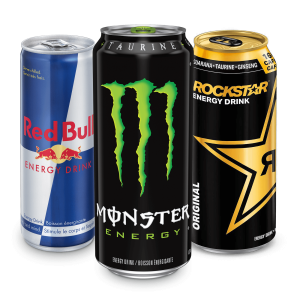 Energy drinks are non-alcoholic beverages designed to boost mental alertness and physical stamina.
Energy drinks are non-alcoholic beverages designed to boost mental alertness and physical stamina.
Energy drinks typically contain high concentrations of caffeine, along with other ingredients such as taurine, glucuronolactone, B-vitamins, herbal extracts, ginseng, guarana, carnitine, choline, vitamin C, vitamin A, vitamin D, electrolytes, sugars, tyrosine, and L-theanine.and amino acids.
Energy drinks are marketed to improve energy, focus, and alertness.
Energy drinks are popular among athletes, students, and military personnel.
The primary ergogenic components of such drinks are caffeine and carbohydrates, which have been shown to enhance physical and cognitive performance.
Energy drinks often contain caffeine levels that can exceed those found in traditional beverages like coffee and tea, and may also include herbal blends and vitamins in high concentrations.
The consumption of these drinks has been associated with increased blood pressure, sympathetic drive, and QT prolongation, raising concerns about potential cardiovascular risks.
Energy drinks may or may not be carbonated and may also contain sugar, other sweeteners, or herbal extracts, among numerous other possible ingredients.
Energy drinks and sugar-sweetened beverages typically contain high levels of sugar, energy drinks include stimulants like caffeine and taurine and are marketed for energy, and sugar-sweetened beverages like sodas and fruit juices usually do not.
Energy drinks have the effects of caffeine and sugar, but there is little or no evidence that the wide variety of other ingredients have any effect.
Most effects of energy drinks on cognitive performance-increased attention and reaction speed, are primarily due to the presence of caffeine.
Energy drinks have been associated with many health risks, such as an increased rate of injury when usage is combined with alcohol, and excessive or repeated consumption can lead to cardiac and psychiatric conditions.
Populations at risk for complications from energy drink consumption include youth, caffeine-naive or caffeine-sensitive, pregnant, competitive athletes and people with underlying cardiovascular disease.
Energy drinks are usually marketed to young people and provide the health effects of caffeine.
Health experts agree that energy drinks which contain caffeine do improve alertness.
The caffeine content of energy drinks is between 50mg and 505mg per serving, compared to 90mg in 250ml of coffee, 50mg in 250ml of tea, and 34mg in 500ml of cola.
There is no reliable evidence that other ingredients in energy drinks provide further benefits.
Marketing of energy drinks has been particularly directed towards teenagers.
It is considered safe for the typical healthy adult to consume a total of 400 mg of caffeine a day.
Adverse effects associated with caffeine consumption in amounts greater than 400 mg include nervousness, irritability, sleeplessness, increased urination, arrhythmia, and dyspepsia.
In the United States, caffeine dosage is not required to be displayed on product labels for food: companies often place the caffeine content of their drinks on the label.
Excessive consumption of energy drinks can have serious health effects resulting from high caffeine and sugar intakes, particularly in children, teens, and young adults.
Excessive energy drink consumption may disrupt teens’ sleep patterns and may be associated with increased risk-taking behavior.
Excessive or repeated consumption of energy drinks can lead to cardiac problems, such as arrhythmias and heart attacks, and psychiatric conditions such as anxiety and phobias.
The consumption of caffeinated energy drinks has been associated with adverse effects on cardiovascular health, including increased heart rate and blood pressure, which can pose risks for individuals with underlying heart conditions.
Energy drinks containing sugar and caffeine have been associated with the deaths of athletes.
The American Academy of Pediatrics recommends that children do not consume caffeinated energy drinks.
Safe levels of caffeine consumption have not been established for children and teenagers.
Energy drink consumption using 192 studies, findings indicate that 54.7% of participants had drank an energy drink at one point, 43.4% in the last 12 months, 32.3% in the past 30 days, 21.6% in the past 7 days, and 8.82% consume energy drinks daily.
Energy drinks are often used as mixers with alcoholic drinks, producing mixed drinks which are similar to but stronger than rum and coke with respect to the amount of caffeine that they contain.
Energy drinks may contain caffeine, B vitamins, carbonated water, high-fructose corn syrup, sucralose or sugar for non-diet versions.
Many energy drinks have high sugar content, contributing to quick energy spikes and subsequent crashes.
Some brands offer sugar-free alternatives using artificial sweeteners like aspartame or sucralose.
Other common ingredients are yerba mate, açaí, taurine, ginseng, maltodextrin, inositol, carnitine, creatine, glucuronolactone or ginkgo biloba.
Taurine is an amino acid thought to have various benefits, including supporting neurological development and regulating water and mineral salts in the blood.
B-Vitamins are often included for their role in energy metabolism.
Ingredients like L-carnitine, which are thought to play a role in energy production.
In the United States, the caffeine content of energy drinks is in the range of 40 to 250 mg per 8 fluid ounce (237 ml) serving.
The FDA recommends that 400 mg per day is safe for adults, while 1200 mg per day can be toxic.
The global energy drink market was estimated to be worth $45.80 billion in 2020 and is predicted to grow at an annual rate of 8.2% to reach $108.40 billion by 2031.
Red Bull had the largest global market share among energy drinks, at 43%, followed by Monster Energy at 39%, Rockstar Energy at 10%, and Amp and NOS, at 3% each.
Many countries and territories have implemented policies such as taxation, bans within schools, sale bans, labeling, and marketing restrictions on energy drinks, usually to reduce consumption among those under 18.
